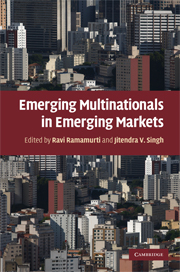Book contents
- Frontmatter
- Contents
- List of figures
- List of tables
- List of abbreviations
- List of contributors
- Acknowledgments
- Part I Introduction
- Part II Country Studies
- 5 Chinese multinationals: Emerging through new global gateways
- 6 Indian multinationals: Generic internationalization strategies
- 7 Russian multinationals: Natural resource champions
- 8 Brazilian multinationals: Surfing the waves of internationalization
- 9 South African multinationals: Building on a unique legacy
- 10 Mexican multinationals: Insights from CEMEX
- 11 Thai multinationals: Entering the big league
- 12 Israeli multinationals: Competing from a small open economy
- Part III Conclusions
- Index
- References
11 - Thai multinationals: Entering the big league
from Part II - Country Studies
Published online by Cambridge University Press: 03 July 2009
- Frontmatter
- Contents
- List of figures
- List of tables
- List of abbreviations
- List of contributors
- Acknowledgments
- Part I Introduction
- Part II Country Studies
- 5 Chinese multinationals: Emerging through new global gateways
- 6 Indian multinationals: Generic internationalization strategies
- 7 Russian multinationals: Natural resource champions
- 8 Brazilian multinationals: Surfing the waves of internationalization
- 9 South African multinationals: Building on a unique legacy
- 10 Mexican multinationals: Insights from CEMEX
- 11 Thai multinationals: Entering the big league
- 12 Israeli multinationals: Competing from a small open economy
- Part III Conclusions
- Index
- References
Summary
The international expansion of companies from emerging markets is increasingly seen as a new defining feature of the global investment landscape. Southeast Asia is one region that has emerged as an important source of FDI. The region accounted for 14 per cent of the total outward FDI stock from developing countries in 2005 (UNCTAD 2007). Within Southeast Asia, Thailand came fourth, following Singapore, Malaysia, and Indonesia, in the 2005 ranking of outward FDI stock. Although Thailand's numbers appear modest when compared with its neighbours, Thailand nonetheless is home to some large regional MNEs, including the CP (Charoen Pokphand) group which has long been one of the largest foreign investors in China. At the same time, the characteristics of Thai outward FDI are markedly different from those of their southern neighbours. While Singapore and Malaysia's outward FDI has been predominantly led by SOEs (so-called government-linked companies, GLCs, in the case of Singapore), Thai outward FDI has mainly been driven by the private sector. The development of Thai multinationals should therefore shed some light on the emergence of other multinationals from developing economies, whose home governments are not directly involved as active players in outward FDI.
This chapter explores the current status of Thailand's emerging multinationals and the challenges facing them in their international expansion through two levels of analysis: country and firm. First, we seek to understand the emergence of Thai multinationals through an analysis of the country's outward FDI.
- Type
- Chapter
- Information
- Emerging Multinationals in Emerging Markets , pp. 312 - 351Publisher: Cambridge University PressPrint publication year: 2009



